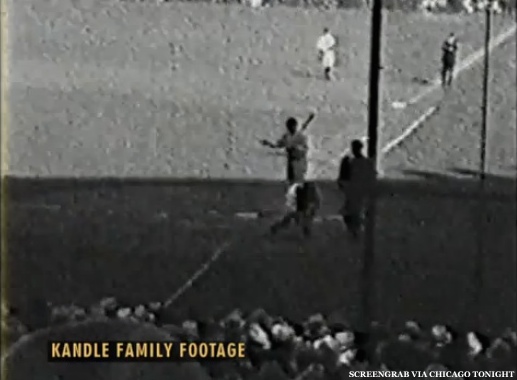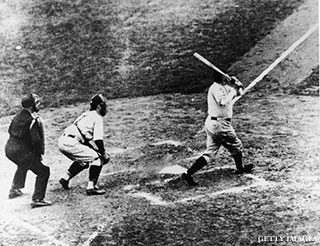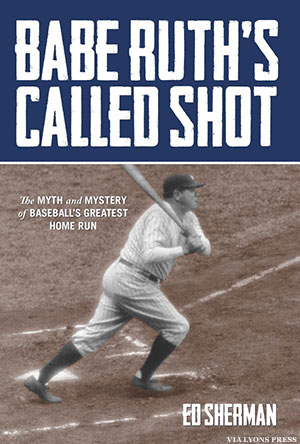Veteran Chicago sportswriter Ed Sherman went to great lengths to research his new book Babe Ruth's Called Shot: The Myth and Mystery of Baseball's Greatest Home Run. He spoke with a U.S. Supreme Court Justice who happened to have attended Game 3 of the 1932 World Series as a youngster in Chicago. The debate may continue to rage about whether Ruth actually called his shot before hitting that titanic home run at Wrigley Field, but Sherman's book provides valuable context and nuance, and if there had been any doubt before this, it also puts the kibosh on Hollywood's interpretation.
ThePostGame: Without ruining the ending, so to speak, what was the most surprising thing you encountered during your research?
ED SHERMAN: The most surprising element was that there wasn't just one gesture. From watching the home video that was discovered decades later, you could see that Ruth had a series of gestures where it could be interpreted that he is "calling his shot.” After a ball to make the count 2-1, Ruth can be seen pointing with his arm straight. Is he pointing to centerfield, or is telling the Cubs players to get back into the dugout? This is the gesture we have seen in the still photos of this famous at-bat.
However, after Ruth took a strike to make the count 2-2, you can see him cocking his arm and pointing his finger. Again, what does this mean? Is he saying he has one strike left? Issuing a warning to pitcher Charlie Root? Or calling his shot here?
And I only saw snippets on that entire at-bat on the home video. It wasn't the whole thing from first pitch to last pitch. Who knows if there weren't more gestures?

TPG: John Paul Stevens attended the game as a 12-year-old fan. Was it surreal to be interviewing a U.S. Supreme Court Justice for his thoughts on this debate?
SHERMAN: Getting a chance to talk to Justice Stevens in his Supreme Court chambers probably was the biggest thrill I had in writing the book. He didn't do interviews when he was on the court. But talk about being at Babe Ruth's Called Shot? For sure. It was great to see that he had a painting of the Called Shot with Ruth pointing and a scorecard of the game hanging on one of the walls. He was very proud to be part of history.
TPG: We can debate about the Tuck Rule play with Tom Brady and the Raiders, or Brett Hull's foot being in the crease against the Sabres, but we all saw those plays and can see them again whenever we want, so it becomes more a matter of interpretation. Is it in some ways cool that the Called Shot does not offer multi-angle, slow-motion replays?
SHERMAN: Yes, indeed. Can you imagine a similar moment occurring today? The opposing team on the field taunting the hitter and the ballpark going crazy during the middle of a game. You can't. Reporters didn't go down to the lockerroom after the game to ask him about it. It wasn't done back then.
The idea that we will never know for sure what happened that day is what makes the tale of the Called Shot endure. MLB history John Thorn said it best: "It doesn't matter whether or not he pointed. What matters is that we're still talking about it."
TPG: Calling his shot might have been considered out of character for Ruth, but wasn't he actually responding to taunting from Cubs players?
SHERMAN: Certainly, that is the theory of the naysayers of the Called Shot. They contend that Ruth was responding to the taunting of the Cubs players, and he definitely was. Ruth was not shy about dishing out trash talk. Obviously, we all know he had a big personality. He definitely was engaging the Cubs players. However, did he do more? Did they push him to the point where he called his shot?

TPG: It wasn't necessarily the case in 1932, but has the Cubs' futility over the years helped sustain the mythology, that this was just another example of embarrassment for a sad-sack franchise?
SHERMAN: I don't think the Cubs' futility has sustained the mythology. This was Ruth's moment, and the Cubs just happened to be the victim. However, it is fitting that in 100 years of baseball at Wrigley Field, the most memorable moment was performed by an opposing player. Now that's definitely very Cub. White Sox fans like me love it.
TPG: This was the final home run Ruth ever hit in a World Series. Is that just another reason why this became so compelling?
The Called Shot was the defining/signature moment of his career. Prior to that, he didn't really have that moment. He never had that game-winning home run in a Game 7 of a World Series. The totality of his career was begging for some kind of act from Ruth that bordered on mythic, super-human. This was his crescendo. If you ask people -- "what's the defining moment of his career?" -- they will invariably hold their arm out and point to some imaginary centerfield. Everyone knows it's the Called Shot.
TPG: It wasn't until many years after Ruth was gone from the game that sports reporters went to the locker room for postgame interviews. Was it amusing to read those accounts, which in many ways probably helped sell the myth?
SHERMAN: I did a chapter on the media coverage of the Called Shot, and the sportswriters added to the mystery of the Called Shot. Many of the sportswriters made no direct mention of Ruth's antics. Only a few suggested that he did something that could be inferred as calling his shot.
Grantland Rice, perhaps the greatest sportswriter ever, didn't mention the Called Shot in his next day story. He waited a second day to recount Ruth's feat with all his signature flourishes. Why did he wait? Was he saving a Called Shot column for another day? Back then, columnists were known to squirrel away their best stories for a particular day. Or was Rice trying play catch up after reading other writers detail the Called Shot? Again, we'll never know, adding yet another element of intrigue to the Called Shot.
TPG: Even if someone wants to believe Ruth called his shot, isn't the Hollywood version of the moment almost comical?
Beyond comical. The first Babe Ruth film is one of the worst movies of all time, sports and otherwise. The Called Shot scene was ridiculous. They somehow tied it to "Little Johnny" lying ill in the hospital. Suddenly, he springs back to life when Ruth hits the homer. The all powerful Babe.
OK, that's the 1940s. You would have expected the modern version starring John Goodman to be more sophisticated and perhaps depict the Called Shot with a bit more mystery. Nope. There was Goodman with his arm stiff as a plank pointing for a count of five. That film was as bad as the original. It's too bad. The Babe deserves a good movie made about him.
TPG: Do you think your book will change anyone's minds if they started out with a firm opinion one way or the other?
SHERMAN: I'm not sure I was able to convince people one way or the other. That wasn't my intent. My goal was to lay out all the facts and let people make up their own minds. This is one point that I would like to stress. The people who maintain the Called Shot is a myth make it seem as if this was an ordinary at-bat. Root, the pitcher, staring for the signs, while Ruth waited for the pitch. Hardly.
Regardless of where you stand about whether Ruth pointed, this was the most unique at-bat in baseball history. During the middle of a World Series game, the Cubs and 50,000 people at Wrigley Field were going crazy. They were challenging Babe Ruth like he never had been challenged before. How did he respond? If he strikes out, perhaps the entire tide of the Series shifts and the Cubs win. Ruth, though, didn't just hit a wind-blown homer that barely went over the fence. He launched a massive blow, traveling nearly 500 feet. It effectively killed the Cubs, leading the Yankees to a four-game sweep.
The greatest player in the game's history delivered as only he could. It was an awesome moment that will live on for a long, long time.
-- Babe Ruth's Called Shot: The Myth and Mystery of Baseball's Greatest Home Run is copyright (c) 2014 by Ed Sherman and published by Lyons Press. Available for purchase from the publisher and Amazon. Read more of Ed Sherman on his site, Sherman Report, and follow him on Twitter @Sherman_Report.





